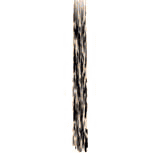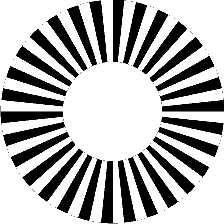View current page
...more recent posts
Wikipedia on Concrete TV:
Concrete TV is a public access show in New York City aired on Channel 67, combining violence, sex, pornography, new video, old video in a video collage artform set to music. This half hour program is produced by Ron Rocheleau, known as "Concrete Ron." It is shown Friday nights at 1:30 AM. Episodes are heavily thematically based in 1980s video, hearkening back to the early MTV days, in a mash-up art style.yatta:
Looks like Fleshbot and BoingBoing have found Ron Rocheleau's Concrete TV, perhaps my most favorite show on MNN ever. Created on two VCRs with worn out "Record" and "Pause" buttons, it was The Cut-Up Method of Brion Gysin channeled through video (I think he's moved on to digital tools since I last saw him.) It was collage that could make Nam June Paik quiver. It was montage that could make Eisenstein cry. It mixed good porn, bad movies and even badder music videos in a way that made pre-ritalin MTV look like the work of hacks. Concrete TV was mashup before most of those folks were out of grade school.Concrete TV website (Episode 9 up now in Quicktime)
Episode 8, part 1: [YouTube]
A gem from Manhattan Public Access Cable. The "fast montage of clips" is a staple of art world video (for some reason everyone who does it, and there are hundreds, thinks no one has ever "deconstructed" TV before) but Rocheleau, whose only brush with the art world that I'm aware of was a video window at Cristinerose's West Broadway gallery, is consistently the hardest, fastest, meanest, skankiest, and most relentless of the lot. He's been at this for a decade and a half. He has great comic timing and between bits fills the screen with endless-seeming montages of car crashes, exploding heads, and booty-shaking strippers. All set to a constantly pounding score of rock, hiphop and techno. It really is the ugly essence of American pop culture. An opinion: one reason it would never fly in the galleries is, it's too blue collar and "male." Too honest about about what the state of the culture is really like, in other words. Also, in fairness, it's probably best encountered channel surfing in the dead of night, not on a monitor in a gallery.
Cassie - "Me & U" [YouTube]
The "U" in the case of this video is Cassie's image in the mirror, for whom she sings, mugs winsomely, strips off her shirt, and pours POWERAde on herself in this immortal tribute to narcissism.
I post it as a basis for comparison to Brains' grime-y remix of the same tune (which you can hear on his MySpace page). He slows down the tempo to near-Romilar level and adds drum and bass burbles, videogame stings and a general all purpose bending of time and space. I envy his production skills and the full, liquid sound he gets--blowing out the car speakers bass notwithstanding. The hyperactive annotations to the Cassie lyrics are by London's m.c. Scorcher. Check it out.
More Brains here.




L.M. Cow Gif Four Times
Paddy Johnson on New Media: Why It Doesn't Suck (her title). MTAA on What a New Media Person Has to Do To Cross Over to the Gallery System (my title):
There are some new media artists who cross over and make it look easy. Cory Arcangel and Jennifer & Kevin McCoy come to mind. Arcangel succeeds by acting a bit like a ethnographer who travels into hacker culture and exports the bits that make sense to the art world. The McCoys succeed by addressing the older tradition of film and not letting themselves geek-out when addressing the art world.Speaking as someone with a sneakerhold in both worlds, I'd rather spend my remaining dwindling critical energy explaining the sacred mysteries of the gallery universe to Internet users than trying to tell a gallery person why a spaceship flying over an endlessly scrolling videogame landscape with the caption "lol, usenet" is funny. My sense is the former crowd is genuinely curious while the latter is boastful of its own cyber-ignorance. I will, however, take a crack at defending a Net Art 2.0 piece that I happen to really like. As Paddy describes it,
[The] Guthrie Lonergan piece MySpace Intro Playlist, a curatorial project that consists of 20 [actual, found] MySpace intro videos, inspires the same questions video art has posed to the viewer for years, “Why am I watching this?” To be honest, even as someone who uses these tools on a regular basis, I still have problems figuring out what to do with this piece. It is a cabinet of curiosities I feel I'd rather see on blogger Jason Kottke’s remaindered links, than to have it exist on the more aggrandized Rhizome Timeshares page.I'd say it's the essence of traditional video art, which deals with themes of construction of identity, guerilla theatre, acting out, and "problematizing" the medium (i.e., using it so badly it becomes self-conscious)--except there is no auteur operating the camera and doing bogus sociology. Nevertheless, as a viewer of this "artist as curator" work, as I said in an earlier post, "I feel a bit like James Stewart in Rear Window watching these normal people doing their awkward and occasionally very funny home movie bits to introduce themselves to a million total strangers. It's completely public domain but feels invasive somehow." That's the artist making me uncomfortable.
Update: In fairness to Paddy, I first encountered that piece on Lonergan's page with a link to YouTube. Some art works best "underground"--as in, you found it yourself or through a small network--and doesn't always survive an institutionally enlarged context. Cory Arcangel's Whitney Artport page is one of the few instances I can think of where an artist's anarchic sensibility completely trumped the "normalizing" effect of a museum web page.




"op wheel" (artist unknown) X 4
I have two videos in the upcoming Chicago Underground Film Festival--"Drum Machine" and "End Notes" (w/ jimpunk). Here is the lineup, excerpted from the website:
MOMENTS OF GREATNESS--MUSIC VIDEOSReally proud and excited to be in this company.
Friday August 18
9:45 PM
Theater One, Music Box Theater, 3733 North Southport
Chicago Underground Film Festival
Size matters! Don't miss your chance to check this amazing batch of underground music vids on a screen larger than your toenail. These inspired blasts of low budget, highly creative mindf*cks won't soon be forgotten.
And the music's killer.
Videos include:
Bonnie "Prince" Billy--Horses, directed by Braden King
Black Mountain--Druganaut, directed by Heather Trawick
Jason Forrest--Steppin' Off, directed by Jon Watts
ASCII Rock--My Generation, directed by Yoshi Sodeoka
Bobby Conn and the Glass Gypsies--Home Sweet Home, directed by Usama Alshaibi
The Juan Maclean--Give Me Every Little Thing
End Notes, directed by Tom Moody with Jimpunk
Camero Rougue--Blowin' Yer Top, directed by Ben Redgrave
Animal Collective--The Fickle Cycle, directed by Scott Colburn
The Sea Calls Us Home, directed by Anie Simpson and Seth Kirby
Kaada--Thank You For Giving Me Your Valuable Time, directed by Robert Ruiz De Castilla
FFFF's--Sheets, directed by Brian Henry
The Gossip--Standing in the Way of Control, directed by Wyld File
Drum Machine--Tom Moody
The Mai Shi--Vampire Beats
Negativland--Guns, directed by Peter Neville
Jamie Lidell--New Me, directed by Aleksandra Domanovic
Chemical Brothers--Come Inside, directed by Ik-kyeong Kwon
Starter Set--In Can Can Descent, directed by Lindsay Beamish
Dirty Three with Chan Marshall--Great Waves, directed by Braden King
Antony and the Johnsons--Hope There Is Someone, directed by Glenn Fogel
Thanks to Eyebeam and Rhizome.org* for reblogging the recent post here on Paul Lansky. That writing's been revised a bit, including fixing one unfortunate flub: the phrase "now a kind of parallel universe to the academic camp" in the second paragraph was missing the "the," which made it sound like the post was calling "music department music" camp or kitsch. Some of it is, but not Lansky's. Some more late thoughts on Lansky's essay "The Importance of Being Digital" follow.
A possible contradiction in the essay: Lansky describes in great detail how analog recording errors can mar the pristine perfection of a digital music composition (such errors are called "artifacts," whether analog or digital). He recounts anecdotally, from the bad old days, all the steps involved in transferring a computer music piece of his to vinyl, each of which introduced artifacts. One of his philosophical selling points for digital technology is its ability to make an artifact-free copy, which is then nearly infinitely reproducible on a mass consumption level. (An aside: Lansky's irritability over intrusive sounds explains much about his music, which is remarkably smooth even at its most boisterous.)
Yet while praising the perfect copy Lansky argues for digital music's ability to exploit the "loudspeaker as instrument." In other words, the speaker is not just a window through which a pre-existing sound reality passes. Woofers and tweeters (and the creators who control them) can actively shape and define their own sonic reality. But if that is the case, why is purity of signal such a virtue? Does clarity even exist if no comparison is to be made to a pre-existing sound?
Lansky describes how analog copying procedures carry with them their own history. A grainy xerox of a smudged newspaper image of a black and white photo, for example, tells a story as much as the underlying picture. Setting aside the fact that digital production has its own artifacts, such as the non-stop yodeling of a skipping CD: this "history" can be just as much a part of that "loudspeaker reality" Lansky champions. In other words, it can serve as content to be actively used by the composer, whether through the deliberate introduction of skips and errors into the recording process, or by adding a patina of age or "period" to music, as in the distinctive mellow hum of an old tube amp: a mix of fact and fiction to be sorted out by the listener.
The point of all this being not to challenge Lansky's core arguments but simply to demote "purity of signal" in the pantheon of digital music's virtues, significantly below "ease of copying," manipulatability, and "ability to define its own reality." If clarity has a virtue at all, it is, as Lansky suggests, that it allows infinite cutting and pasting in the composition process without changing the sound in undesired ways due to accumulating artifacts. Being able to create a "richer," "fuller" sound from the rich pallette of prior recorded or previously unrecorded sounds allows the composer to more accurately trigger associations in the listener while at the same time plugging this data into the composition's imaginary patchbay of abstraction and representation.
*Update, 2011: Eyebeam reblog archives are dead. The Rhizome link has been changed to http://rhizome.org/editorial/2006/aug/12/p-lansky-club-vs-academic-electronic-music/. Please note that I authored the post, not Marisa Olson.
I've been going back over my YouTube posts from the past few months--a surprisingly large amount are dead links because they've been removed "for terms of service violations" or "by user." Read: people received greasy lawyer letters and got scared. As if some grainy, tiny crap video from the '70s is something anybody deserves to profit from. Amazing how many creative types don't get the viral thing at all.
